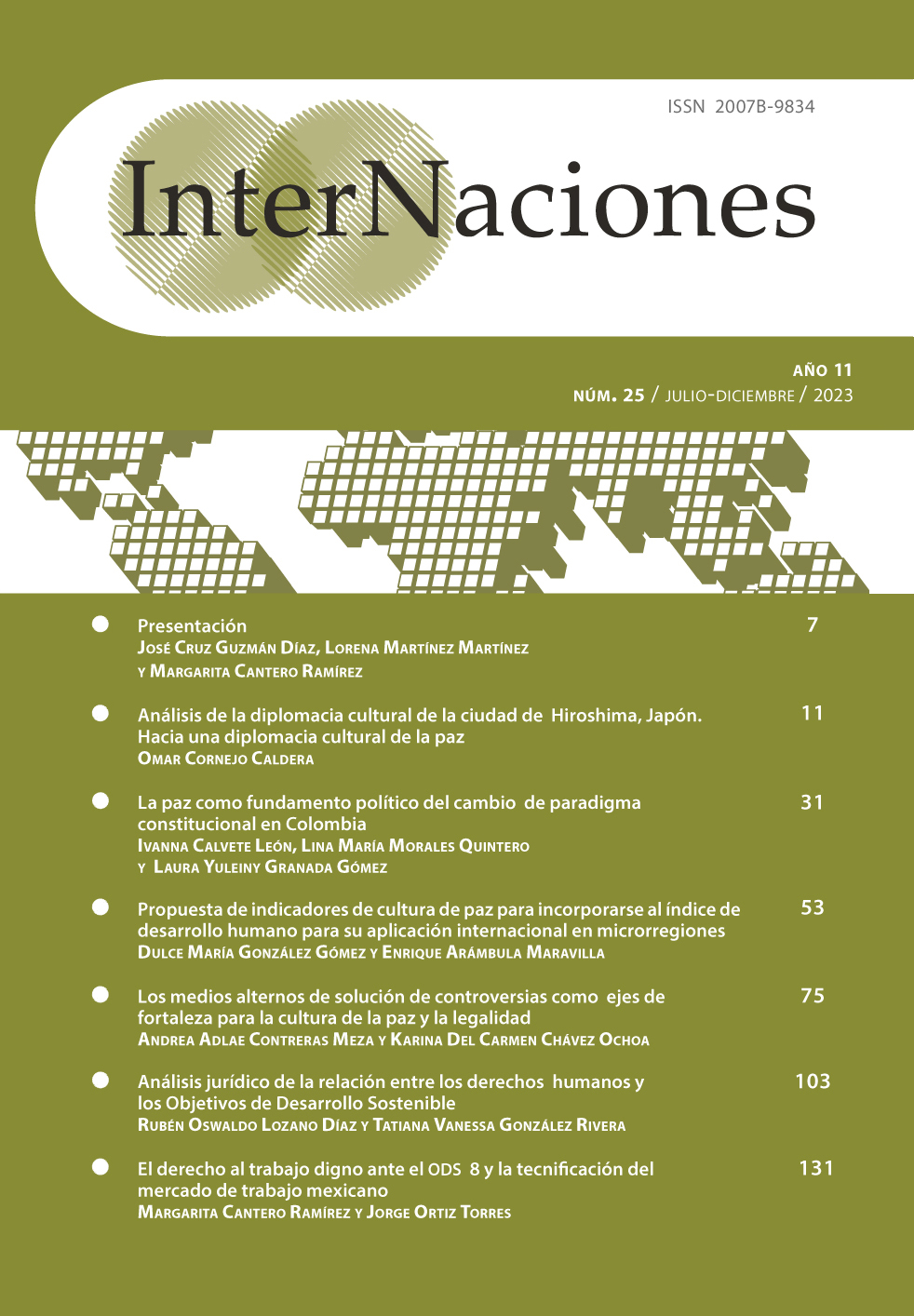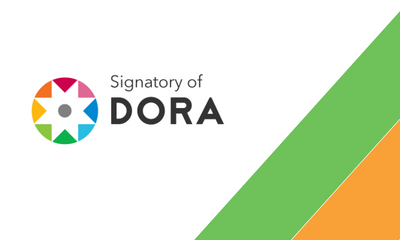Analysis of the cultural diplomacy of the city of Hiroshima, Japan.
Towards a cultural diplomacy of peace.
DOI:
https://doi.org/10.32870/in.vi25.7255Keywords:
Peace studies, Cultural diplomacy, Paradiplomacy, Nuclear disarmament, Non-traditional actorsAbstract
This article will study the Japanese cities of Hiroshima, and in parallel Nagasaki, in their journey to create a paradiplomacy focused on nuclear disarmament. The objectives are to study the cultural diplomacy created by the Japanese cities promoting disarmament among the International Community, through the analysis of the diplomatic actions of these substate actors, demonstrating the results focusing on international nuclear disarmament.The relevance of this work is towards the introduction of the concepts and methodologies of Peace investigations (PI) and its comments around the traditional theories of international relations, taking as an example two cities that have based their public policies on the work for peace and nuclear disarmament. Therefore, this article deals with the implications of the paradiplomacy of the cities of Hiroshima and Nagasaki in nuclear disarmament strategies at the international level, taking into account the participation of cities as international actors.Downloads
References
Barba, F. R. (2015). Cultural diplomacy. What is it and what it is n’t? 18.
Berg, R. (2008). ¿Están forjando los estudiantes un mundo más pacífico? Boletín de oie, 50(1), 15-16.
Bosch, M. M. (1996). La no proliferación de armas nucleares a fines del siglo xx. Revista Mexicana de Política Exterior, 50, 130-160.
Dietrich, W., Alvarez, J. E., & Koppensteiner, N. (2006). Key texts of peace studies. lit Verlag Münster.
Espinosa Méndez, A. M. (2013). La proyección de imagen a partir de Soft Power, mediante Nation Branding y Diplomacia Pública en el caso de Japón, durante el periodo 2002 – 2010 [Bachelor Thesis, Universidad del Rosario]. En Dinnie, K., Nation Branding. Concepts, Issues, Practice. Oxford: Butterworth-Heinemann, 2008. https://doi.org/10.48713/10336_4380
Exteriores, S. de R. (2016). México, histórico promotor del desarme nuclear y la no proliferación. gob.mx. http://www.gob.mx/sre/fr/articulos/mexico-historico-promotor-del-desarme-nuclear-y-la-no-proliferacion
Gil Rodríguez, F. (2018). El Tratado de Tlatelolco: Tan vigente como hace 50 años. Revista de Relaciones Internacionales de la unam, 129. http://www.revistas.unam.mx/index.php/rri/article/view/63237
Grasa, R. (2010). Cincuenta años de evolución de la investigación para la paz: Tendencias y propuestas para observar, investigar y actuar. https://dialnet.unirioja.es/servlet/libro?codigo=608031
HPCF (2004). Hiroshima Peace Culture Foundation. http://www.pcf.city.hiroshima.jp/hpcf/english/about/index.html#purpose
Jaramillo Jassir, M. (2015). Poder blando y diplomacia cultural: Elementos claves de políticas exteriores en transformaciones. Editorial Universidad del Rosario.
Kramer, K. (2013). Las autoridades locales como actores constructores de paz en el marco de la cooperación descentralizada. Institut Universitari d’Estudis Europeus - UAB.
López-Martínez, M. (s/f). Manual de paz y conflictos. Recuperado: 19 de mayo de 2022, de http://wpd.ugr.es/~eirene/wp-content/files/publicaciones/ColeccionEirene/eirene_manual/Historia_de_la_Paz.pdf
Mirek, H. (1986). El tratado de tlatelolco. Limitaciones y resultados. 14.
Miyazaki, H. (2021). Hiroshima and Nagasaki as models of city diplomacy. Sustainability Science, 16(4), 1215-1228. https://doi.org/10.1007/s11625-021-00968-1
Montoya Ruiz, S. (2014). La redefinición de la diplomacia cultural en el mundo contemporáneo (Redefinition of Cultural Diplomacy in the Contemporary World) (SSRN Scholarly Paper N° 2394146). Social Science Research Network. https://papers.ssrn.com/abstract=2394146
Montoya, S. (2012). La redefinición de la diplomacia cultural en el mundo contemporáneo [Tesis, Universidad de Externado de Colombia]. file:///C:/Users/Propietario%20Asus/Downloads/SSRN-id2394146.pdf
Muñoz, F. A. (s/f). La paz imperfecta. 36.
Muñoz, F. A., & Arenas, J. M. J. (2012). Desfragmentar, o armonizar, al ser humano desde la perspectiva compleja de la investigación para la paz. RECERCA. Revista de Pensament i Anàlisi, 12, 61-86.
Muñoz, F. A., & Carmona, J. B. (s/f). La praxis (teoría y práctica) de la paz imperfecta. 24.
Musch, A., & Sizoo, A. (2009). City Diplomacy: The role of local governments in conflict prevention, peacebuilding and post-conflict reconstruction | Knowledge Platform Security & Rule of Law. vng International. https://www.kpsrl.
org/publication/city-diplomacy-the-role-of-local-governments-in-conflict-prevention-peacebuilding-and-post-conflict-reconstruction
Osorio, J. (2016). Influencia de la cultura popular en las relaciones internacionales: poder blando en el este de Asia (Influence of the Popular Culture in International Relations: Soft Power in East Asia) (SSRN Scholarly Paper N°
. Social Science Research Network. https://doi.org/10.2139/ssrn.2830331
Pérez Esquivel, A. (2014). La cultura y las tradiciones como factores fundamentales de la diplomacia durante la ocupación estadounidense (1945-1952) y como influyó para el Milagro Japonés. https://repositorioinstitucional.buap.mx/handle/20.500.12371/5856
Pérez, L. A. V. (2014). POP POWER: Diplomacia Pop para una Sociedad Global.
Priewe, S. (2020). Cultural Diplomacy & the City: Part Two. usc Center on Public Diplomacy. https://uscpublicdiplomacy.org/blog/cultural-diplomacy-city-part-two
Rodriguez Barba, F. (2015a). Cultura y Diplomacia: La Diplomacia Cultural de Québec a 50 años de la Doctrina GérinLajoie. Reflexión Política, 17(33), 6-19.
―――― (2015b). Diplomacia Cultural. ¿qué es y qué no es? Espacios Públicos, 18(43), 33-49.
Rubbi, L. N. (2016). Arsenales nucleares en el mundo. https://repositorio.uade.edu.ar/xmlui/handle/123456789/4933
Toro Calonje, A., & Toro Calonje, A. (2020). Procesos de comunicación para la paz. Anagramas -Rumbos y Sentidos de la Comunicación-, 18(36), 115-137. https://doi.org/10.22395/angr.v18n36a7
Downloads
Published
How to Cite
Issue
Section
License
Copyright (c) 2023 University of Guadalajara

This work is licensed under a Creative Commons Attribution-NonCommercial-ShareAlike 4.0 International License.
CC BY-NC-SA 4.0 https://creativecommons.org/licenses/by-nc-sa/4.0/

























